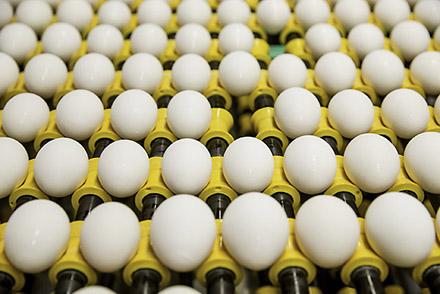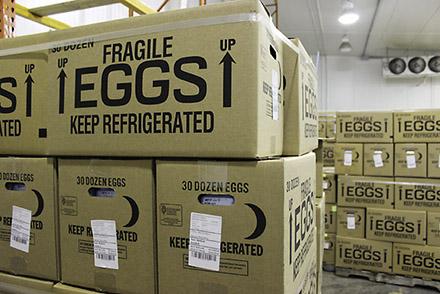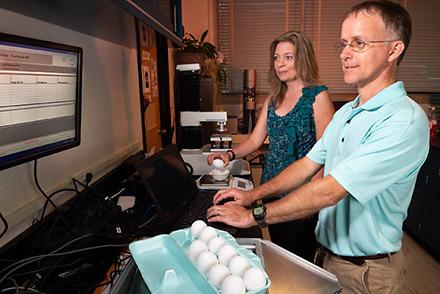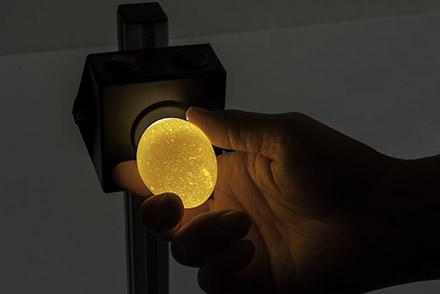How We Store Our Eggs—and Why

Eggs on a conveyor belt entering the washing system. (The American Egg Board, D3992-1)
It is a question anyone who has ever eaten or cooked an egg might want to ask: How should we store them? That’s because the way eggs are stored depends on where they’re produced.
Prompted by concerns about spoilage and foodborne illnesses, U.S. egg producers and processors began washing and refrigerating their eggs in the early 1970s. Other countries soon followed suit, and eggs are now washed and refrigerated in Canada, Japan, and Scandinavia. But the approach has never caught on in most of the European Union, where eggs are neither washed nor refrigerated. They are kept at room temperatures, even in stores. The rationale is that a chicken egg is coated with a thin, protective “cuticle,” or membrane, that prevents Salmonella and other bacteria from penetrating the shell. Some Europeans argue that makes refrigeration unnecessary and that washing the egg washes away the cuticle.
“The long-held belief in Europe has been that you don’t want to disturb the cuticle of the egg after it comes out of the reproductive tract because it’s protective,” says Deana Jones, an Agricultural Research Service (ARS) food technologist in Athens, Georgia.
In a comprehensive study, Jones and colleagues compared the quality of eggs stored using the European and U.S. approaches, along with two other common storage techniques. Their results, published in Poultry Science, show that the U.S. approach is the most effective, ensuring the highest quality eggs after 15 weeks of storage.
The results were not surprising, because refrigeration is generally considered a cornerstone for maintaining the quality of so many fresh foods, Jones says. Moreover, previous research has shown that the cuticle degrades after the egg is laid, diminishing its protective effect. “We know that the cuticle dries and comes off, and we also know that from an evolutionary standpoint, it isn’t there to prevent Salmonella in the egg, but to control respiration during incubation,” she says.

Washed and packaged eggs in refrigeration awaiting distribution. (The American Egg Board, D3993-1)
Exporting Eggs To Fill Supply Gaps
Jones says the study is intended to clear up doubts and confusion prompted by the different handling and storage practices. The differences prevent eggs from being more freely traded on international markets, which exacerbates the supply gaps and price hikes that occur—in both the United States and Europe—when there are disease outbreaks and egg recalls.
“Eggs are a major source of nutrition throughout the world, and in some areas, an egg shortage means people are less likely to get the protein they need to stay healthy,” Jones says.
Jones says the study was also necessary because current washing and refrigeration standards were adopted in the 1970s, but egg-production practices have changed since then.
“The feed is more controlled, the hens have been bred to be more consistent, and the eggs they produce are more uniform in terms of quality, shelf life, and other factors,” she says. “We don’t want to be basing our decisions about egg storage on practices and production systems that are outdated and no longer in use.”
The U.S. Department of Agriculture (USDA) inspects egg-processing plants four times a year, and the U.S. Food and Drug Administration requires egg producers to maintain storage temperatures of 45 ˚F, beginning 36 hours after the eggs are laid. Producers with fewer than 3,000 chickens are exempt from the federal regulations, so eggs sold at roadside stands and farmer’s markets may be covered by a patchwork of state laws and health codes.
Making the Grade
About 60 percent of the eggs sold in the United States come from processors who participate in USDA’s grading service, voluntarily paying to have their eggs graded so the eggs can display a “USDA Grade A” or “AA” shield on their cartons. The grade is based on qualities that can be observed in the shell, yolk, and egg white when the egg is inspected with lights and other specialized equipment. Specifics on egg-grading criteria can be found here.
Egg processors who participate are required to spray-wash their eggs with warm water and use a sanitizing rinse and air-drying techniques specified by USDA’s Agricultural Marketing Service (AMS).

At an ARS test kitchen, technicians Robin Woodroof and Stephen Norris weigh eggs and record the data during a 15-week study of 5,400 eggs. (Gerald Heitschmidt, D3994-1)
“We require very specific washing and rinsing procedures for participation, but as a practical matter, every producer in the United States washes their eggs. It’s an industry standard,” says Mark Perigen, national supervisor for AMS’s shell egg quality assessment division. After washing, all eggs must be stored at refrigerated temperatures according to USDA Food Safety and Inspection Service requirements.
Perigen says Jones’s study is being widely circulated, and it is likely to help keep overseas markets open to U.S. eggs because it uses science-based evidence to demonstrate that eggs shipped from the United States will stay fresh for up to 90 days. “Showing objectively that our eggs maintain their quality can be a very strong selling point,” he says.
U.S. producers currently export 3.4 percent of their eggs and egg products, and increasing exports is a strategic priority for the American Egg Board (AEB), which represents the nation’s egg producers.
“We find that foreign customers are eager to purchase high-quality U.S. eggs,” says John Howeth, AEB’s senior vice president for market development. He added that Jones’s Poultry Science results are being widely discussed in egg industry meetings and forums. “These results, along with past ARS research, have been extremely beneficial in promoting egg safety and quality.”

“Candling” eggs to look for quality downgrades. The grade is based on qualities that can be observed in the shell, yolk, and egg white when the egg is inspected with lights. (Gerald Heitschmidt, D3995-1)
Study Methods and Results
In her study, Jones compared the quality of 5,400 eggs that were stored using the four primary egg-handling conditions found throughout the world: unwashed and refrigerated; unwashed and stored at room temperature (72 ˚F); washed and refrigerated (at 39 ˚F); and washed, coated with mineral oil, and refrigerated (egg processors will sometimes spray eggs with mineral oil or food oil to retain moisture and prevent bacteria from penetrating the shell). She used the same USDA standards used in commercial egg-processing plants to grade the eggs (grades AA, A, and B), and she weighed them each week for 15 weeks.
The results showed that the refrigerated eggs, regardless of whether they were washed or oiled, were still Grade A quality after 15 weeks, on average, and that the quality of eggs stored at room temperature declined rapidly. In fact, unwashed eggs stored at room temperature degraded from Grade AA to Grade B in just a week, and they also lost 15 percent of their weight over the 15 weeks. Under refrigeration, the unwashed eggs lost the same amount of weight as the washed eggs.
“Basically, the key is that egg quality stays high with refrigeration and degrades rapidly without it,” Jones says.
The study can be found here.—By Dennis O’Brien, ARS Office of Communications.
You May Also Like

